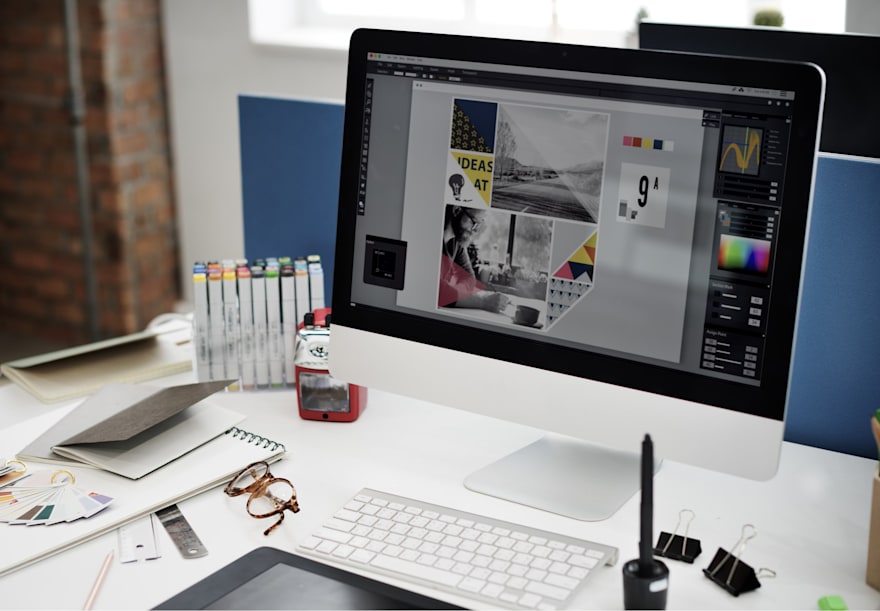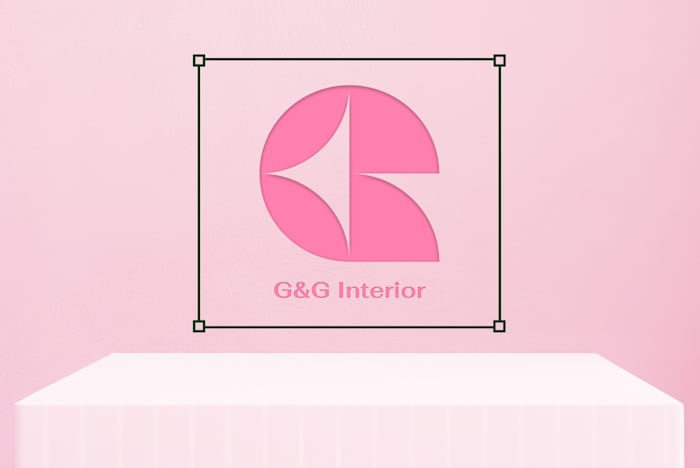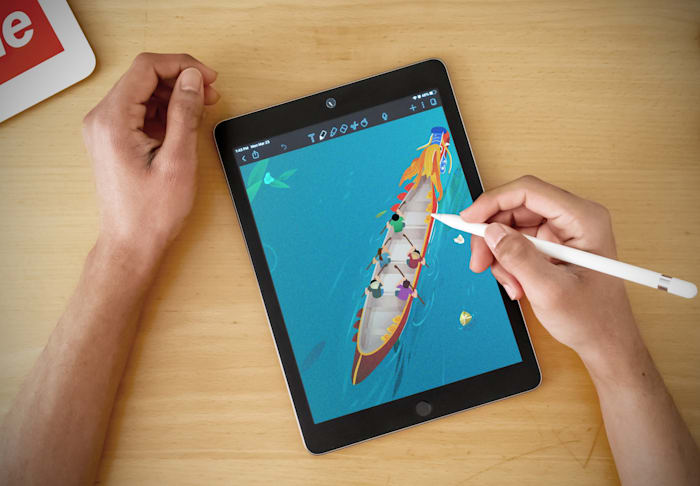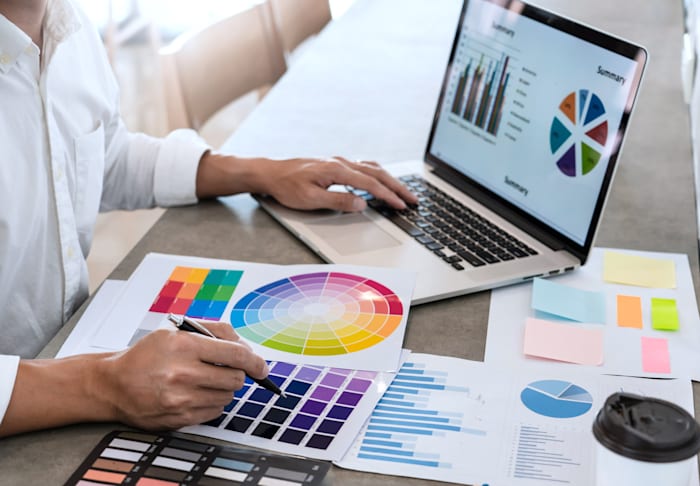What is graphic design?
An introduction to graphic design
 February 4, 2021
February 4, 2021 9 minute reading
9 minute reading
If you’re not placing utmost importance on graphic design within your business, you're doing it wrong. You see, graphic design is responsible for communicating tailored messages, establishing brand identity, attracting target audiences, and enhancing usability, all of which are vital for the future success of your business.
If you don’t know a lot about graphic design, including the reasons why it is important for any business, then you’re in luck. We’ve written this practical guide to tell you all there is to know about this practice.
What is Graphic Design?
1. Graphic design definition
Graphic design uses visual and textual elements such as typography, photography, iconography, and illustration to communicate ideas or messages, which therefore influence our perceptions. It is most commonly utilized for projects, events, campaigns, or products, and aims to help the producer connect with their target consumer through these visual and textual cues.
Common examples of graphic design work you might see every day include:
Marketing materials, such as flyers, brochures, and posters
Product packaging and labels
Website layouts
Infographics
Web and social media advertisements
T-shirt and apparel designs
Magazines, newspapers, and catalogs
Graphic design can be broken down as serving two important functions: creating aesthetics that maximize usability and creating visuals that shape users’ emotions. Let’s look at each of these in more depth below.
Graphic design creates aesthetics that maximize usability
On the surface, graphic design is about attracting a target audience using visual elements such as graphics, color, and typography, however, the craft must also take into consideration one vital element: user experience. This is particularly true for those working in the field of user experience (UX) design, as they must take on a human-centered approach to their work.
Along with considering the visual appeal of graphics, designers must aim to maximize usability to ensure what they design also serves a purpose. This means not only considering how a button on a sales page, for example, must look stylistically (including color, shape, outline, size, etc.), but also where it should be placed on the page to enhance both the user’s experience and conversion rates. Therefore, graphic design must consider a user’s visual processing abilities too.
Graphic design creates visuals that shape users’ emotions
Graphic design also has strong ties with emotional design, as designers must take a viewer’s emotions, expectations, and beliefs into consideration when creating visuals. This is where color theory comes into play, as the chosen color palette will not only convey certain messages to a viewer but influence their emotional response to the design too. For example, red is a color that is often seen to signify danger or an alert, whereas blue is associated with the ocean and sky, and therefore encourages a more tranquil response.
Graphic design therefore must use elements, including typography, that match the tone of the piece and shape a user’s emotions as they interact with the overall design from start to finish. Essentially, graphic design is also about making design considerations with user psychology in mind.
As you can see, graphic design differs from visual arts in the fact that it doesn’t just concentrate on beauty; rather, it ensures beauty and usability go hand-in-hand.
2. The basic principles of graphic design
Now that you know what graphic design is, it’s important to learn the elements and principles that make up design, as these serve a vital role within the field.
The elements of graphic design include:
Color
Size
Shape
Line
Form
Texture
Space
These elements can be used in combination or contrast to each other in order to create visuals that are eye-catching and highly effective.
The basic principles of graphic design include:
Contrast
Balance
Rhythm
Emphasis
Movement
Proportion
Think of these as a set of guidelines that help a designer to achieve the perfect composition in a piece.
3. Types of graphic design
As you’ve probably realized by now, graphic design is quite broad. Although it contains a set of general ‘rules’ or guidelines, the industry is made up of several specializations, each focusing on a different type of graphic design.
Let’s look at the various types of graphic design in more detail.
Visual identity graphic design
A brand identity is the collection of elements a business uses to portray its desired image to the consumer, including its:
logo
color palette
typography
other visual elements
This is where visual identity graphic design comes into play, as it is responsible for designing the elements that form the brand’s visual identity.
Visual identity graphic designers will often create a set of brand guidelines (or ‘style guides’) that help to establish visual brand consistency across marketing or branding assets into the future. The visual identity of a brand is extremely important, which is why this sub-category is the most common type of graphic design.
Marketing and advertising graphic design
Graphic design helps organizations promote and communicate their brand, products, and services in a more effective, visual manner. Marketing and advertising graphic design include:
magazine ads
vehicle wraps
flyers
brochures
billboards
web banners
social media ads
postcards
trade show displays
User interface graphic design
A user interface refers to the things a person uses to interact with a device or application, including the keyboard, screen, or mouse. Therefore, when we refer to user interface graphic design, this involves the user’s visual experience with the interface and its design, such as the buttons, menus, and more. Although a user interface must have technical functionality, it’s equally as important for it to have an aesthetic appeal that makes it enjoyable and easy to operate.
Examples of user interface graphic design include:
Web page design
Desktop app design
Game interfaces
Mobile app design
Theme design, such as for WordPress, Shopify, Squarespace, etc.
Publication graphic design
Publication graphic design is the application of graphic design elements and principles to long-form pieces that are publicly distributed to communicate with an audience. Examples include:
Books
Magazines
Newspapers
Catalogs
Newsletters
Reports
Directories
Although publication graphic design once solely referred to print mediums, it now also refers to digital forms of publishing, an area that has dramatically increased in popularity within the last decade alone.
Packaging graphic design
Packaging graphic design is built on the belief that every protective casing for a product can be an opportunity to delight consumers and tell the brand’s story. It includes choices in:
Material
Form
Texture
Graphics
Colors
Fonts
It aims to provide consumers with a sensual experience and engage them through sight, touch, sound, smell, and/or taste, depending on the product. Additionally, good packaging design should be able to convey the answers to the following questions, all within a glance:
What is the product?
Who is the product for?
How and why are people buying the product?
Motion graphic design
As the term suggests, motion graphics just refers to graphics that are moving (or in motion). This can include animation, typography, video, illustrations, and other design elements that are used in online media, television, and film. Common examples include:
Lyric videos
Title sequences and end credits
Animated logos
Video games
GIFs
Tutorial videos
Banners
It takes the core components of graphic design, including its elements and principles, and adds movement to it. The aim is that through adding movement, it keeps the viewer engaged visually for longer, all while effectively illustrating an idea or message to them.
Environmental graphic design
Environmental graphic design is a broad area of design that merges graphic, architectural, interior, landscape, and industrial design. Its main goal is to improve people’s experiences within their environment by making them more memorable, fascinating, helpful, or easier to navigate.
Examples include:
Wall murals
Signage
Interiors of retail stores, event spaces, offices, etc.
Museum exhibitions
Public transport navigation
Interactive displays
Ultimately, environmental graphic design provides visual cues that help people not only identify where they are but also get from their current destination to their desired destination without confusion.
Art and illustration for graphic design
While graphic design involves the use of art and illustration, it’s important to note that these disciplines still remain separate. This is because, while graphic designers create and assemble visual pieces to communicate messages or enhance an individual’s experience, artists and illustrators create original artwork for purposes such as decoration, fine art, or storytelling.
Art and illustration, however, are often created for commercial use within graphic design and can be found in advertisements, packaging, branding, and marketing materials. Therefore, it is vital to include these mediums within this section.
4. The importance of graphic design in business
There’s no denying how vital graphic design is for businesses, especially in today’s fast-paced, visually-driven society. Research indicates that:
90% of the information transmitted in the human brain is visual
65% of the population are classified as ‘visual learners’
Visuals are processed 60,000 times faster than text
To understand the critical importance graphic design plays in a business, it’s helpful to look at exactly which areas of a business rely on the practice.
Logo design
Your logo is what separates your business from its competitors and it's the most important design asset you have representing your brand. It's often the first thing a target customer will see in relation to your company and therefore has the ability to set a great first impression and persuade them to do business with you. While typography plays a vital role in the success of your logo, so too does its color palette. Graphic design utilizes color theory to ensure your logo's color palette communicates the right message to the right audience and evokes the emotions you want them to feel when interacting with your brand.
Find a logo designer for hire
Advertising
Without a hero image, bold typography, and a clear call to action, it is highly unlikely your advertisement will capture attention, let alone convert prospects. If you want to cut through the noise and deliver your advertising message quickly and effectively, then your advertisement needs to adhere to the elements and principles of graphic design that we discussed earlier. Remember, graphic design aims to condense large amounts of information and convey it visually for greater ease, both of which are necessary for advertising.
Website design
The aim of your brand’s website should be to attract, engage, and convert visitors, and this just isn’t possible without the visual cues and aesthetically pleasing organization of information that graphic design allows. You see, graphic design elements and principles allow us to enhance a user’s experience, all while successfully moving them from A to B on your website through navigational prompts, clear messaging, and expertly placed calls to action.
Sales collateral
Materials developed to help boost the sales process, such as product catalogs or brochures, also rely heavily on graphic design to enhance a business’ brand and messaging. They incorporate visual elements such as pleasing typography, appropriate imagery, and cohesive formatting to ensure the brand’s aims, voice, and the message isn’t lost on the page.
Marketing collateral
Similarly, with your advertising and sales collateral, your marketing collateral relies heavily on graphic design to capture attention, increase brand recognition, and attract sales. Remember, good marketing designs lead to a boost in credibility, and good credibility will encourage your customers to trust you with their wants and needs, therefore increasing conversions. Through the creation of a brand style guide, you can also ensure your marketing collateral remains cohesive and in line with your brand.
Social media
Using custom branded visuals across your social media allows you to tie your online presence to your digital and physical branding, therefore further establishing cohesiveness. It also boosts the authenticity and integrity of your brands’ voice and encourages consumers to follow and interact with your brand on social media.
Presentations
Almost 85% of presentations are said to be highly visually focused, meaning that design plays a vital role in these projects. As we mentioned earlier, 90% of the information transmitted in the human brain is visual, so you’ll need to capitalize on this through the visual appearance of your presentation if you want to succeed. Through the use of colors, typography, and imagery, you can keep your audience engaged throughout the presentation and ensure it flows seamlessly from one slide to the next.
Packaging design
A popular saying goes, “we eat with our eyes,” but did you know that as humans, we shop with our eyes too? This is why it’s important for your product packaging to encompass graphic design elements and principles, as you’ll not only want to leave a lasting impression but also capture the attention of your target audience. Perfectly designed packaging adheres to the company’s branding and understands the visual hierarchy. Additionally, it is designed with your target customer’s desired aesthetic, taste, wants, and needs in mind.
5. Common graphic design jobs
The graphic design industry has changed rapidly over the last two decades alone, with a significant shift from print graphic design to digital graphic design. This reflects businesses' growing reliance on digital forms of media and advertising, including through websites, eCommerce, and social media.
In fact, it is believed that by 2028 the employment of graphic designers in computer systems design services will grow by 24%.
Graphic design also encompasses several different roles within the industry, with each focusing on a specialized area or job position, such as:
The creative director
The creative director is the head of a creative team responsible for planning and designing the layout and visuals for print and digital assets. They determine the creative vision of the project and require excellent time management, leadership, team management, and budgeting skills.
Although they predominantly lead the creative team through the process of completing the project, they too often take part in the visual design process and collaborate with roles such as copywriters, art directors, and graphic designers.
The art director
The art director is in charge of the overall production of an artistic project, whether it be in theater, marketing, publishing, fashion, film, or video games. Along with directing other artists to bring about the successful completion of the project, they too create the design and contribute their ideas.
It is important for an art director to work closely with the client or employer in order to create a finished project that not only meets the desired goals and overall design but the budget too.
The graphic designer
A graphic designer creates and assembles visual elements such as images and typography to produce a piece of design, whether by hand or by using computer software. Their main aims are to inspire, inform, and attract consumers, and they do this through using the elements and principles of design, both of which we outlined previously in this guide.
They are experts at communicating messages or ideas visually, hence why they are also sometimes referred to as communication designers. Graphic designers may sometimes collaborate with other creative professionals too, such as artists, illustrators, or animators, to bring their design to life.
Along with having an excellent eye for design, graphic designers are also praised for being communication experts and visual-thinking problem solvers.
The web designer
A web designer designs and arranges the appearance and layout of a web page, including content and graphics. Their major goals are to make the web page aesthetically pleasing and highly functional, contributing to a positive customer experience. A web designer has immense knowledge of coding, as they must use this to layout the website, and will keep things such as SEO and rankings in mind when designing the page, to increase its success.
The user experience (UX) designer
The user experience (UX) designer differs from the web designer, as their role is to focus solely on the experience of the user, therefore working on the ‘behind the scenes’ of the design. They aim to understand how a user thinks and feels, and rely heavily on user research, usability testing, content strategy, and related data. They are less about the visual elements of a web page or application and more about forming a strategy to deliver the best user experience possible. As a result, however, web designers and UX designers often work closely together.
Conclusion
Graphic design serves an important role in the way consumers interact with, perceive, and experience your brand, so it’s vital that you not only understand the practice but also embrace it within your business.
Furthermore, the elements and principles of graphic design are applied to communicate specific messages, establish brand identity, attract target audiences, and enhance usability, all of which are necessary for your business to not only survive but thrive.


